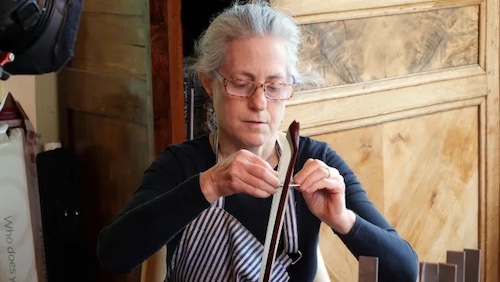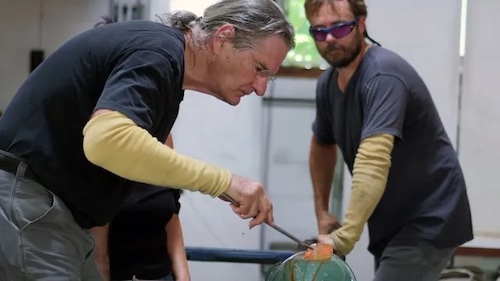Communiqué
Celebrate the joy of music with “Harmony” on CRAFT IN AMERICA – Dec. 10 at 9:00 pm
< < Back toCraft in America
“Harmony”
Friday, December 10th, 2021 at 9 pm
HARMONY bridges the art forms of music and craft, celebrating the joy of music and the creation of handcrafted instruments.
Featured in this episode
 Susan Lipkins is a highly respected bowmaker who specializes in bass bows. Her handcrafted, made-to-order bows now have a waiting list of ten years, as she only completes ten bows in a year. Susan’s expertise earned her a Gold Medal at the Violin Society of America’s 2012 competition – the first and so far only woman to be so honored. Although she studied the bass, she gravitated toward bow making and apprenticed under some of the best bow makers in the world. She takes particular pride in addressing the concerns of the musicians who will use her bows.
Susan Lipkins is a highly respected bowmaker who specializes in bass bows. Her handcrafted, made-to-order bows now have a waiting list of ten years, as she only completes ten bows in a year. Susan’s expertise earned her a Gold Medal at the Violin Society of America’s 2012 competition – the first and so far only woman to be so honored. Although she studied the bass, she gravitated toward bow making and apprenticed under some of the best bow makers in the world. She takes particular pride in addressing the concerns of the musicians who will use her bows.
“I enjoy working with my clients to make a bow for them that will compensate for any shortcomings of their individual bass, such as a sound that is too bright or too dark or too sluggish.”
In Woodstock, New York, Susan shares a workshop with her husband, David Wiebe, a maker of fine stringed instruments: violins, viola, cellos and basses.. Her clients are in a wide range of celebrated orchestras including the Pittsburgh Symphony, the New York Philharmonic, and the Scottish BBC Symphony Orchestra to name a few.
 Doug Naselroad is the founder of the Appalachian School of Luthiery, Director of the Troublesome Creek Stringed Instrument Co., and a master luthier who specializes in the mountain dulcimer. Naselroad has been making stringed instruments since 1969. After opening Naselroad Guitars in Mt. Sterling, KY in 1979, Doug developed a signature line of stringed instruments and door harps that have been sold around the world. In 2012, Doug was selected as the Appalachian Artisan Center’s Master Artist in woodworking, and he founded the Appalachian School of Luthiery located on Main Street in Hindman, KY, where he leads the Culture of Recovery Program, an apprenticeship for those recovering from opioid addiction. Those who study instrument making with him at the Culture of Recovery program have said that this opportunity is providing them with a new, positive outlook on life. Some of the graduates go on to become luthiers, and many take the ability to master a skill into other occupations.
Doug Naselroad is the founder of the Appalachian School of Luthiery, Director of the Troublesome Creek Stringed Instrument Co., and a master luthier who specializes in the mountain dulcimer. Naselroad has been making stringed instruments since 1969. After opening Naselroad Guitars in Mt. Sterling, KY in 1979, Doug developed a signature line of stringed instruments and door harps that have been sold around the world. In 2012, Doug was selected as the Appalachian Artisan Center’s Master Artist in woodworking, and he founded the Appalachian School of Luthiery located on Main Street in Hindman, KY, where he leads the Culture of Recovery Program, an apprenticeship for those recovering from opioid addiction. Those who study instrument making with him at the Culture of Recovery program have said that this opportunity is providing them with a new, positive outlook on life. Some of the graduates go on to become luthiers, and many take the ability to master a skill into other occupations.
Naselroad specializes in the mountain dulcimer; an instrument which originated in Hindman, Kentucky in the late 19th century. The mountain dulcimer, with its curved silhouette and heart-shaped sound holes is as beautiful as it is musically authentic, and crafting one is a complex construction process involving precise cutting, shaping, carving, and tuning.
 With a career that spans over 40 years, Richard Jolley is one of today’s most accomplished glass sculptors. His figurative work uses organic forms to explore the breadth of the human experience; from the body to nature to science. Born in Wichita, Kansas, Jolley moved to Oak Ridge, Tennessee in his youth. He has continued to call East Tennessee his home, even making the unconventional decision to establish his glass studio in Knoxville in 1975. Jolley began his fine art studies at Tusculum College in 1970 and later completed his BFA at George Peabody College (now part of Vanderbilt University). He has participated in over 64 solo museum and gallery exhibitions across the country and internationally, and his work is included in the collections of several prominent institutions including the Carnegie Museum of Art, Corning Museum of Glass, Knoxville Museum of Art, Los Angeles County Museum of Modern Art, Museum of Fine Arts, Boston, and the Renwick Gallery of the Smithsonian American Art Museum, Washington, DC.
With a career that spans over 40 years, Richard Jolley is one of today’s most accomplished glass sculptors. His figurative work uses organic forms to explore the breadth of the human experience; from the body to nature to science. Born in Wichita, Kansas, Jolley moved to Oak Ridge, Tennessee in his youth. He has continued to call East Tennessee his home, even making the unconventional decision to establish his glass studio in Knoxville in 1975. Jolley began his fine art studies at Tusculum College in 1970 and later completed his BFA at George Peabody College (now part of Vanderbilt University). He has participated in over 64 solo museum and gallery exhibitions across the country and internationally, and his work is included in the collections of several prominent institutions including the Carnegie Museum of Art, Corning Museum of Glass, Knoxville Museum of Art, Los Angeles County Museum of Modern Art, Museum of Fine Arts, Boston, and the Renwick Gallery of the Smithsonian American Art Museum, Washington, DC.
In May 2014, Jolley’s steel and glass masterwork Cycle of Life: Within the Power of Dreams and the Wonder of Infinity, opened at the Knoxville Museum of Art. Five years in the making, Cycle of Life is one of the largest figural glass assemblages in the world. The installation is composed of thousands of blown glass and steel elements and symbolically depicts six successive phases of life: Primordial, Emergence, Desire, Tree of Life, Contemplation, and Sky. “It’s a figurative range of people and nature,” Jolley says. “The question was how to distill the life cycle to fit the space and answer the questions: Who are we? Where are we? Where do we come from? Where are we going?”

